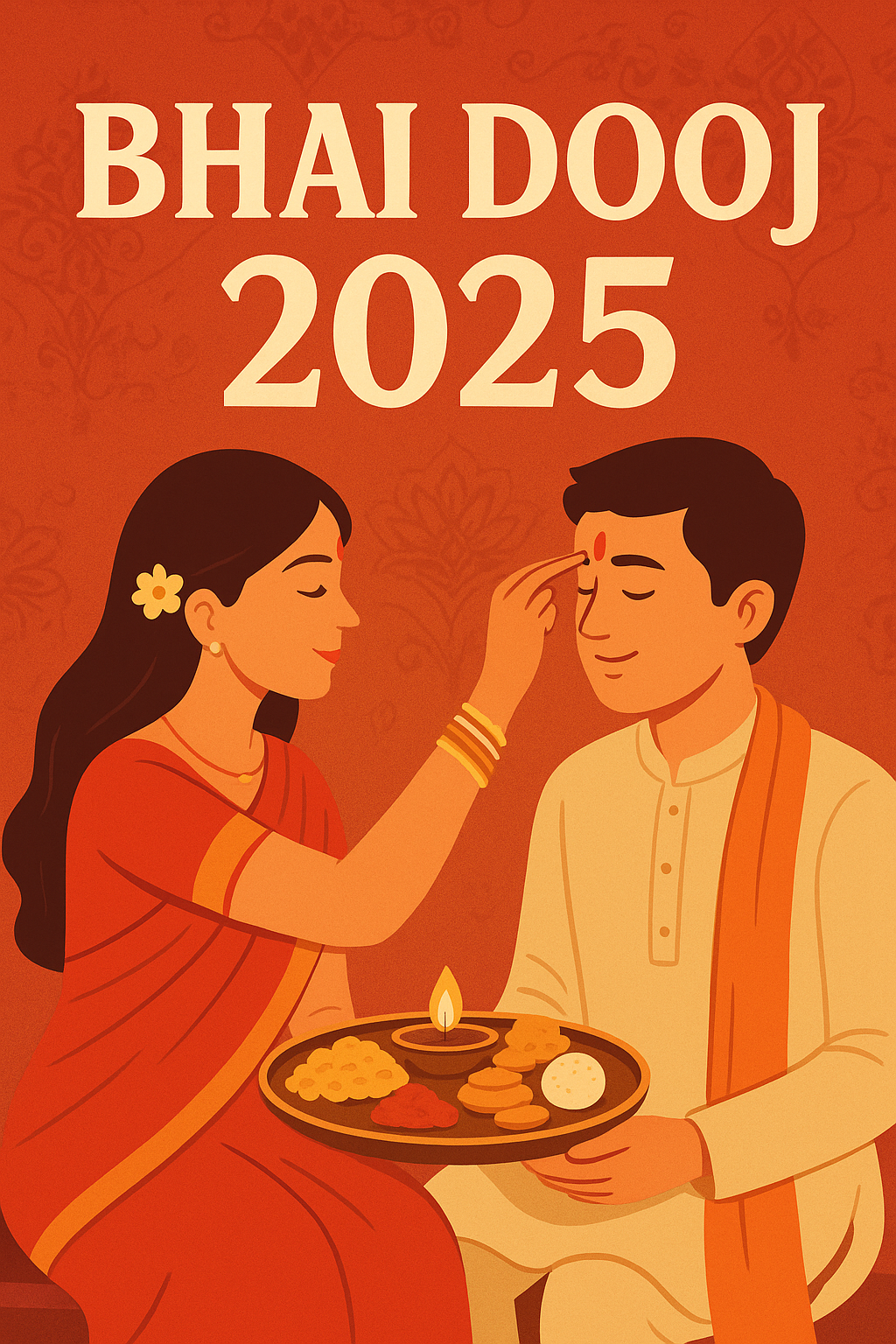
When Is Bhai Dooj 2025? Date, Muhurat, Time, Significance and Rituals
Bhai Dooj, also known as Bhaiya Dooj, Bhau Beej, Bhai Phonta, or Bhai Tika, is a cherished Hindu festival that beautifully honors the sacred bond between brothers and sisters. Celebrated just two days after Diwali, it marks the conclusion of the festive season with love, prayers, and family togetherness. In 2025, Bhai Dooj will be observed on Thursday, 23 October 2025, when sisters perform aarti, apply a protective tilak on their brothers’ foreheads, and pray for their long life and prosperity. In return, brothers express gratitude and shower their sisters with blessings and gifts. The festival is deeply rooted in mythology, with legends of Lord Yama and Yamuna, and Krishna and Subhadra adding divine meaning to the celebration.
1. Bhai Dooj 2025: Date & Tithi
1.1 Date in 2025
In 2025, Bhai Dooj falls on Thursday, 23 October 2025
This is based on the Hindu lunar calendar: Bhai Dooj is observed on the Dwitiya (second) Tithi of Shukla Paksha (bright fortnight) in the month of Kartika (in the amanta or purnimanta tradition)
According to Drik Panchang, for New Delhi: the relevant Dwitiya Tithi starts earlier and continues through the day, making 23 October the correct date for the festival in 2025.
It is important to check local calendars (panchang) because in some regions, due to time zones or local lunar calculations, the effective Tithi can differ slightly.
1.2 Holi Bhai Dooj — Another Occurrence
In some parts of India, especially in the northern and eastern regions, an additional Bhai Dooj is observed after Holi, called Holi Bhai Dooj, Bhratri Dwitiya, or Holi Bhai Tika. In 2025, Holi Bhai Dooj is on Sunday, 16 March 2025.
- Dwitiya Tithi begins on 15 March at 14:33 and ends on 16 March at 16:58 (local time)
- Many sources confirm Holi Bhai Dooj celebrated on 16 March 2025
However, the more widely observed Bhai Dooj (post-Diwali) on 23 October 2025 is the main event for most regions.
2. Auspicious Muhurat (Timing) for Bhai Dooj 2025
To maximize the spiritual benefit, sisters normally perform the tilak / tika and aarti of their brothers during an auspicious time (muhurat). Below are some timings known for 2025 — always cross-check with a local panchang:
- Puja Muhurat is 11:30 AM to 1:05 PM IST on 23 October 2025.
- The Dwitiya Tithi begins on 22 October at 11:18 PM and ends on 23 October at 9:30 PM (local).
- Drik Panchang gives specific local timings for Bhaiya Dooj in Delhi, which can vary regionally.
Guidelines for choosing the muhurat:
- The tilak / aarti should be performed while the Dwitiya Tithi (Shukla Paksha) is active
- Avoid Rahukaal, Gulika (inauspicious periods)
- If possible, choose mid-morning to early afternoon windows
- For exact local muhurat, consult a trusted regional panchang or priest
Performing the rituals in the muhurat is believed to bring stronger blessings, longevity, and protection for the brother.
3. Significance, Myths & Legends
3.1 The Symbolism of Bhai Dooj
Bhai Dooj celebrates the loving, protective bond between a sister and a brother. On this day:
- Sisters pray for the long life, prosperity, and well-being of their brothers
- Brothers in turn pledge to protect, support, and cherish their sisters
- The day strengthens sibling ties, family bonds, respect, and emotional connection
As GaneshaSpeaks notes, the festival is all about expressing love between siblings, with sisters offering prayers and brothers reciprocating with gifts.
Various regional names reflect its wide cultural reach:
- Bhau Beej in Maharashtra, Goa
- Bhai Phonta in West Bengal
- Bhai Tika in Nepal
- Yama Dwitiya / Yamadvitiya in some traditions (after the god Yama)
3.2 Mythological Stories
Several legends are associated with Bhai Dooj. Some of the most popular are:
3.2.1 Yama and Yamuna Legend
One of the oldest and most widely cited stories involves Yama (the god of death) and his sister Yamuna. According to the legend:
- Yama visited his sister Yamuna on the Dwitiya day
- Yamuna warmly welcomed him, performed aarti, applied tilak, and offered sweets
- Touched by her devotion, Yama blessed her and decreed that any brother who visits their sister on this day and receives tilak will be granted a long and prosperous life, and protection from harm
- Therefore, sister’s prayers on Bhai Dooj are believed to protect the brother from untimely death and difficulties
3.2.2 Krishna & Subhadra Story
Another widely narrated myth connects to Lord Krishna and his sister Subhadra:
- After defeating the demon Narakasura, Krishna visited his sister Subhadra
- Subhadra welcomed him with sweets, flowers, and performed aarti and tilak on his forehead
- This symbolizes celebration, gratitude, and care in the sibling bond
- Many believe this event is the origin of the Bhai Dooj ritual tradition
These legends reinforce the themes of love, protection, respect, and close familial relationships intrinsic to Bhai Dooj.
4. Rituals & Puja Vidhi: How to Observe Bhai Dooj 2025
Here is a step-by-step ritual guide and variations across regions, suitable for Bhai Dooj 2025:
4.1 Preparations (Ahead of the Ritual)
- Clean & decorate the home — especially the puja area. Use rangoli, flowers, auspicious symbols.
- Take a ritual bath, wear clean/new clothes.
- Invite the brother (or ensure his arrival) — if physical presence is not possible, some families perform the ritual via video call.
- Assemble the puja thali (plate) with items like:
-
- Roli / kumkum (vermilion)
- Unbroken rice grains (akshat)
- Sweets (ladoos, barfi, kheer)
- Betel leaves, coconut, flowers
- A diya (lamp)
- Incense sticks, camphor
- Fruits, dry fruits, water, sacred thread (kalava)
4.2 The Ritual (Puja / Tilak / Aarti)
- Invoke deities — begin by invoking Lord Ganesha (remover of obstacles) and other gods/ancestors as per family custom.
- Prepare the tilak mixture — some use kumkum + rice, or vermilion + sandalwood + yogurt + rice, etc.
- Apply tilak by the sister — she applies the tilak (roli + rice) on the brother’s forehead, often while reciting mantras or prayers.
- Perform Aarti — sister waves the diya (lamp) in front of her brother, doing circular movements, accompanied by chanting or prayers.
- Offer sweets, fruits, gifts — sister offers the brother sweets, fruits, coconut, etc. Brother may give gifts or cash in return.
- Brother’s blessing / vow — the brother offers blessings, a promise to protect, or may touch his sister’s feet, or present a gift.
- Feasting together — a special meal is prepared (often by sister) with the brother’s favorite dishes. The whole family may dine together.
4.3 Regional Variations & Customs
- In Maharashtra / Goa, Bhau Beej is common. Sisters may place the brother on a rangoli seat and perform the tilak ritual in a distinct style.
- In West Bengal, Bhai Phonta, sisters prepare a special phonta (tilak) made from rice, sandana, yogurt and chant Sanskrit verses.
- In Nepal, Bhai Tika (Bhai-Teeka / Bhai-Tihar) is celebrated on the fifth day of Tihar. Sisters make a multicolored tika (often 7 colors) and set up a mandap or decorative area.
- In parts of Uttar Pradesh / Bihar, Bhatra Dwitiya is observed with symbolic clay figurines or special rituals.
These regional practices preserve the underlying spirit — sibling affection, protection, and blessings.
5. Significance & Lessons from Bhai Dooj
Bhai Dooj is more than a ritual — it carries deeper spiritual, cultural, and social meaning:
-
Strengthening Family Bonds
The festival reinforces the emotional ties between siblings and within the broader family, encouraging love, understanding, and mutual respect. -
Gratitude & Blessings
Sisters express gratitude and prayers; brothers reciprocate with gifts and promises of protection. This mutual exchange deepens appreciation. -
Cultural Identity & Continuity
Observing rituals, legends, and traditional prayers helps younger generations stay connected to heritage and values. -
Blessings for Well-being & Longevity
According to tradition, the sister’s tilak and prayers are believed to protect the brother from harm and grant him long life. -
Final Note to Diwali Celebrations
Bhai Dooj often marks the last day of the Diwali festival period — a concluding day of familial joy, light, blessings, and togetherness.
6. Tips for Celebrating Bhai Dooj 2025 Meaningfully
- Plan ahead — send invitations or reminders to siblings, especially if they stay elsewhere
- Clean and decorate the home and puja area
- Prepare the puja thali in advance with all required items
- Consult a local panchang or priest for your region’s muhurat
- For siblings who are distant, perform the ritual via video call, or send a symbolic puja thali or gift
- Personalise gifts — something thoughtful, not just generic
- After rituals, engage in heartfelt conversation, share memories, and strengthen bonds
7. Frequently Asked Questions (FAQs)
Q1. When is Bhai Dooj 2025 in India?
A1. Bhai Dooj 2025 is on Thursday, 23 October 2025 (Dwitiya Tithi of Shukla Paksha in Kartika) according to standard Hindu calendars.
Q2. What is the puja muhurat for Bhai Dooj 2025?
A2. A commonly cited muhurat is 11:30 AM to 1:05 PM IST on 23 October 2025. Always verify with a local panchang for your city.
Q3. Why is Bhai Dooj celebrated? What is the significance?
A3. Bhai Dooj celebrates the bond between brother and sister. Sisters pray for their brothers’ long life, while brothers pledge protection and love. The festival is rooted in legends like Yama & Yamuna and Krishna & Subhadra.
Q4. What are the main rituals of Bhai Dooj?
A4. Major rituals include: tilak / tika by sister, aarti, offering sweets/fruits, gift exchange, prayers, and a family feast.
Q5. Is Bhai Dooj observed twice in some years (e.g. Holi Bhai Dooj)?
A5. Yes. Many communities also observe Holi Bhai Dooj (Bhratri Dwitiya) after Holi. In 2025, Holi Bhai Dooj is on 16 March 2025.
Q6. What are the regional names of Bhai Dooj?
A6. Some regional names include:
- Bhau Beej (Maharashtra/Goa)
- Bhai Phonta (West Bengal)
- Bhai Tika / Bhai Teeka (Nepal)
- Yamadvitiya / Yama Dwitiya in some regions
Q7. What if a brother and sister are far apart?
A7. They may perform the ritual via video call, send a symbolic thali or gift, or schedule the tilak ceremony when physically reunited. Some families adapt creatively while preserving the spirit of the festival.
Conclusion
Bhai Dooj 2025 on 23 October offers a beautiful opportunity to honor sibling love, respect, and devotion. When observed with sincerity — especially in the auspicious muhurat — the rituals serve as a bridge across hearts, strengthening familial connection across distances and generations.
By understanding its date, symbolism, and correct ways of worship, you and your loved ones can make Bhai Dooj 2025 a meaningful, memorable celebration. May the sister’s prayers protect her brother, and may every brother cherish and uplift his sister — now and always.
